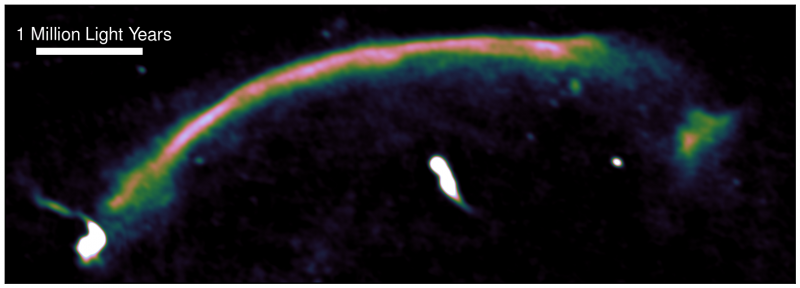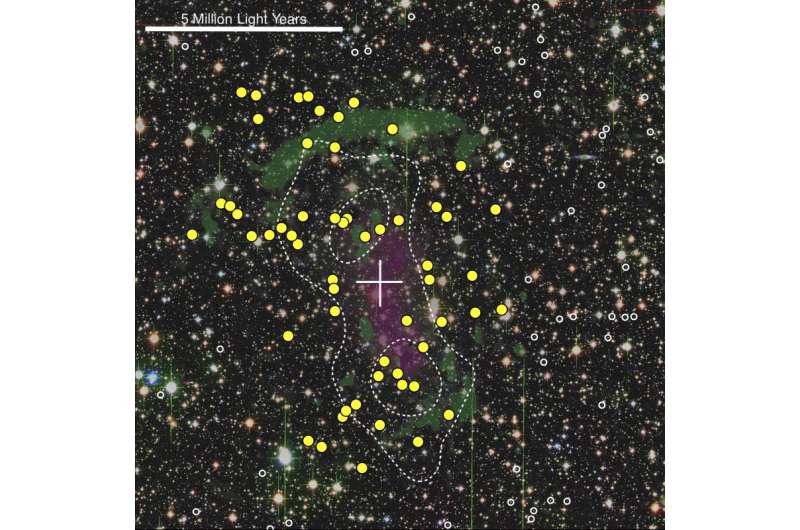Giant cosmic tsunami wakes up comatose galaxies

Galaxies are often found in clusters, with many 'red and dead' neighbours that stopped forming stars in the distant past. Now an international team of astronomers, led by Andra Stroe of Leiden Observatory and David Sobral of Leiden and the University of Lisbon, have discovered that these comatose galaxies can sometimes come back to life. If clusters of galaxies merge, a huge shock wave can drive the birth of a new generation of stars – the sleeping galaxies get a new lease of life. The scientists publish their work in the journal Monthly Notices of the Royal Astronomical Society.
Galaxy clusters are like cities, where thousands of galaxies can be packed together, at least in comparison to the empty space around them. Over billions of years, they build up structure in the universe - merging with adjacent clusters, like growing cities absorb nearby towns. When this happens, there is a huge release of energy as the clusters collide. The resulting shock wave is like a tsunami, but until now there was no evidence that the galaxies themselves were affected very much.
Stroe and Sobral observed the merging galaxy cluster CIZA J2242.8+5301, nicknamed the 'Sausage', located 2.3 billion light years away in the direction of the constellation of Lacerta, in the northern hemisphere of the sky. They used the Isaac Newton and William Herschel Telescopes on La Palma, and the Subaru, CFHT and Keck Telescopes on Hawaii, and found that far from 'watching from the back' the cluster galaxies were transformed by the shock wave, triggering a new wave of star formation.
Stroe comments: "We assumed that the galaxies would be on the sidelines for this act, but it turns out they have a leading role. The comatose galaxies in the Sausage are coming back to life, with stars forming at a tremendous rate. When we first saw this in the data, we simply couldn't believe what it was telling us."
The new work implies that the merger of galaxy clusters has a major impact on the formation of stars. "Much like a teaspoon stirring a mug of coffee, the shocks lead to turbulence in the galactic gas. These trigger an avalanche-like collapse, which eventually leads to the formation of very dense, cold gas clouds that are vital for the formation of new stars", says Stroe.

Sobral adds: "But star formation at this rate leads to a lot of massive, short-lived stars coming into being, which explode as supernovae a few million years later. The explosions drive huge amounts of gas out of the galaxies and with most of the rest consumed in star formation, the galaxies soon run out of fuel. If you wait long enough, the cluster mergers make the galaxies even more red and dead – they slip back into a coma and have little prospect of a second resurrection."
Every cluster of galaxies in the nearby Universe has experienced a series of mergers during its lifetime, so they should all have passed through a period of extremely vigorous production of stars. Given that the shocks will only however lead to a brief (in astronomical terms) increase in star formation, astronomers have to be very lucky to catch the cluster at a time in its evolution when the galaxies are still being `lit up' by the shock.
The next step is to see if the Sausage is unique and that these bursts of star formation need very particular conditions. By studying a much bigger sample of galaxies, the team hope to find out exactly how they happen.
More information: "The rise and fall of star formation in z ∼ 0.2 merging galaxy clusters." MNRAS. (June 11, 2015) Vol. 450 646-665 DOI: 10.1093/mnras/stu2519
"MC2: boosted AGN and star formation activity in CIZA J2242.8+5301, a massive post-merger cluster at z = 0.19." MNRAS (June 11, 2015) Vol. 450 630-645 DOI: 10.1093/mnras/stv521
Journal information: Monthly Notices of the Royal Astronomical Society
Provided by Royal Astronomical Society





















